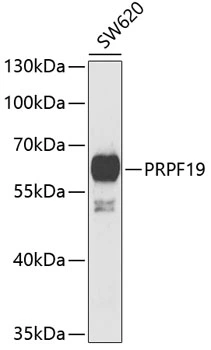PRP19 antibody [C1C3]
GTX106952
ApplicationsImmunoFluorescence, Western Blot, ImmunoCytoChemistry, ImmunoHistoChemistry, ImmunoHistoChemistry Paraffin
Product group Antibodies
TargetPRPF19
Overview
- SupplierGeneTex
- Product NamePRP19 antibody [C1C3]
- Delivery Days Customer9
- Application Supplier NoteWB: 1:500-1:3000. ICC/IF: 1:100-1:1000. IHC-P: 1:100-1:1000. *Optimal dilutions/concentrations should be determined by the researcher.Not tested in other applications.
- ApplicationsImmunoFluorescence, Western Blot, ImmunoCytoChemistry, ImmunoHistoChemistry, ImmunoHistoChemistry Paraffin
- CertificationResearch Use Only
- ClonalityPolyclonal
- Concentration1.04 mg/ml
- ConjugateUnconjugated
- Gene ID27339
- Target namePRPF19
- Target descriptionpre-mRNA processing factor 19
- Target synonymsNMP200, PRP19, PSO4, SNEV, UBOX4, hPSO4, pre-mRNA-processing factor 19, PRP19/PSO4 homolog, PRP19/PSO4 pre-mRNA processing factor 19 homolog, RING-type E3 ubiquitin transferase PRP19, nuclear matrix protein 200, nuclear matrix protein NMP200 related to splicing factor PRP19, psoralen 4, senescence evasion factor
- HostRabbit
- IsotypeIgG
- Protein IDQ9UMS4
- Protein NamePre-mRNA-processing factor 19
- Scientific DescriptionPSO4 is the human homolog of yeast Pso4, a gene essential for cell survival and DNA repair (Beck et al., 2008 [PubMed 18263876]).[supplied by OMIM]
- Storage Instruction-20°C or -80°C,2°C to 8°C
- UNSPSC12352203
References
- Kuo RL, Li ZH, Li LH, et al. Interactome Analysis of the NS1 Protein Encoded by Influenza A H1N1 Virus Reveals a Positive Regulatory Role of Host Protein PRP19 in Viral Replication. J Proteome Res. 2016,15(5):1639-48. doi: 10.1021/acs.jproteome.6b00103Read this paper
- Tenzer S, Moro A, Kuharev J, et al. Proteome-wide characterization of the RNA-binding protein RALY-interactome using the in vivo-biotinylation-pulldown-quant (iBioPQ) approach. J Proteome Res. 2013,12(6):2869-84. doi: 10.1021/pr400193jRead this paper





